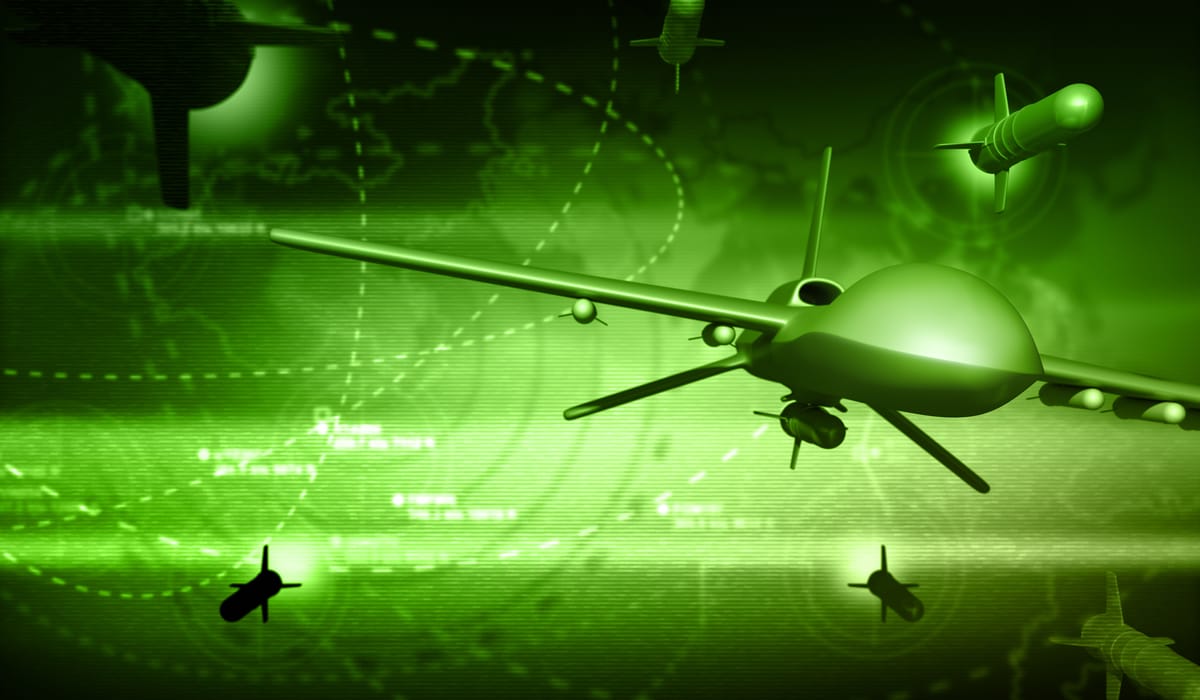The Future of Defence: Accelerating Transformation in an Era of Ubiquitous Sensing
Deterrence and victory will hinge on software speed, resilient networks, and affordable mass.

- Defence is shifting from platform-centric forces to networked kill webs under ubiquitous sensing, demanding dispersion, deception, and resilient command.
- Advantage depends on pairing exquisite assets with affordable autonomous mass, hardened logistics, and dominance in the electromagnetic spectrum and cyber.
- Outperformance requires procurement at software speed, assured human–machine teaming, and cultures that prioritise time and learning across the United States, China, and other powers.
Defence is entering a decisive transition. Experience from recent conflicts, together with rapid advances in autonomy, sensing, and computation, is reshaping how militaries find, decide, and strike. The shift is not simply from analogue to digital, it is from platform-centric force design to networked, software-defined, data-rich systems that must operate under constant surveillance and electromagnetic pressure. For the United States, China, and other powers, advantage will hinge less on any single exquisite platform and more on the speed, resilience, and affordability of entire webs of sensors, decision tools, and effectors.
From platforms to kill webs
Modern operations compress the time between detection and engagement, and this compresses doctrine with it. Proliferated satellites, high-altitude and tactical uncrewed systems, passive radio-frequency sensors, and ground robots now create dense, overlapping fields of view. Survivability therefore depends on signature management, deception, dispersion, and mobility. The traditional model of a few large, scarce assets is giving way to mixed fleets that combine a limited number of high-end platforms with large numbers of attritable and expendable systems. Loitering munitions and one-way attack drones are being treated as ammunition rather than bespoke assets, while decoys and electronic effects are becoming a standard part of the magazine.
Both the United States and China are moving towards kill webs rather than linear kill chains. The American push for Joint All-Domain Command and Control aims to connect sensors, shooters, and decision-makers across services and theatres. Chinese concepts of informationised and intelligentised warfare emphasise system-of-systems confrontation, where paralysing an opponent’s networks can be as decisive as destroying hardware. The practical implication is similar for both, forces must close the loop faster than the adversary while riding out disruption, and must do so with architectures that remain effective when individual nodes are jammed, deceived, or destroyed.
Ubiquitous sensing, counter-sensing, and the electromagnetic fight
If everything can be seen, everything can be targeted, and therefore everything must learn to hide. Investments are flowing into multi-static radar, passive detection, low-probability-of-intercept communications, and automated target recognition. Electronic warfare, cyber operations, and spectrum manoeuvre have moved from specialist enablers to theatre-wide, day-one activities. Jamming, spoofing, and deception are now planned alongside kinetic fires, while disciplined emissions control is becoming a survival skill for units at every echelon. Space systems remain essential for positioning, navigation, timing, and wide-area intelligence, surveillance, and reconnaissance, yet they are also vulnerable to kinetic and non-kinetic attack. Resilience requires diversified orbits, rapid reconstitution, and terrestrial fallbacks for communications and PNT, supported by mission command that assumes intermittent connectivity.
Mass, cost, and the return of attrition
Precision still matters, but quantity has returned as a determinant of campaign outcomes. Stockpiles of air defences, long-range fires, and loitering munitions can be expended at rates that outstrip peacetime production, which pushes nations to re-evaluate industrial basing, surge capacity, and the balance between exquisite and “small, smart, many”. The lesson is not that tanks or crewed aircraft are obsolete, it is that they must operate as hubs within networks of cheap sensors, decoys, and autonomous teammates, and they must be supported by factories that can replenish losses quickly. The United States is working to scale munitions output and accelerate the fielding of attritable autonomy, while China’s large industrial base and military-civil fusion policies are designed to mobilise commercial capacity for defence needs. Middle powers are carving out sovereign niches in missiles, air defence, undersea systems, and uncrewed surface vessels, often in partnership to reach scale.
Command, control, and human-machine teaming
Artificial intelligence is altering the tempo of reconnaissance, targeting, and battle damage assessment. The most successful applications so far are narrow and fast, for example object detection, route planning, electronic order of battle estimation, and predictive maintenance. Decision support tools can prioritise targets, anticipate logistics bottlenecks, and generate options, yet human command remains central for legal, ethical, and strategic reasons. Western forces tend to emphasise human-in-the-loop or on-the-loop control for weapon release, rigorous test and evaluation, and transparent assurance. Chinese writing on intelligentised warfare envisages deeper integration of autonomy to accelerate decision cycles, while retaining political and strategic primacy for human leadership. Across all systems, telemetry, data provenance, and fail-safe behaviour are just as important as model accuracy, since adversaries will contest training data, attempt to spoof sensors, and exploit any brittleness in algorithms.
Geography and operational design
The character of competition differs by theatre. In the Indo-Pacific, distances, maritime chokepoints, and anti-access systems foreground long-range sensing, anti-ship fires, undersea manoeuvre, air denial, and distributed maritime operations. In Europe, dense ground ISR, layered air defence, long-range artillery duels, and contested logistics create a more continuous land fight. In both cases, forces must sustain themselves under persistent surveillance and long-range attack. This pushes designs that favour smaller, dispersed units, mobile command posts, austere airstrips and ports, and fuel and munition distribution that can survive interdiction, with rapid repair and deception baked into daily routines rather than reserved for crisis.
Grey-zone contest and cognitive defence
Competition below the threshold of armed conflict is now permanent. Lawfare, economic coercion, coast guard and maritime militia operations, cyber intrusions into critical infrastructure, and information campaigns shape the battlespace long before shots are fired. Democracies need credible attribution mechanisms, calibrated ladders of response, and societal resilience plans that include rapid myth-busting, trusted crisis communications, and hard protection for electoral, health, and financial systems. Authoritarian states are likely to continue exploiting speed, deniability, and narrative discipline. Neither approach guarantees dominance, and both are learning. The common requirement is the ability to detect manipulation quickly, to coordinate state and private responses, and to impose proportionate costs without escalating unintentionally.
Procurement, software, and the industrial base
The bottleneck is less invention and more the ability to buy, field, and update at software speed. Effective forces are converging on modular open systems that avoid vendor lock-in and enable rapid insertion of new sensors, effectors, and algorithms. Secure DevSecOps pipelines, continuous integration and delivery, and digitally signed updates to the edge are becoming standard for weapons software. Evidence-based assurance, including synthetic environments, red-teaming, and telemetry-driven safety cases for autonomy, is replacing one-off certification. Funding models are shifting from single-point programmes to portfolios that back families of systems and tolerate fast failure where learning value is high. Industrial strategies are being rebuilt around critical inputs such as energetics, microelectronics, and advanced composites, with dual-use manufacturing and surge capacity treated as part of deterrence. The United States is experimenting with rapid acquisition pathways and reform of budget processes that historically favoured predictability over speed. China’s theatre command structure and military-civil fusion are intended to tighten joint execution and shorten the path from commercial innovation to military use, although operational transparency and combat-validated integration remain challenges that only real stress can test.
Workforce and operating culture
Digital, electronic warfare, and data engineering skills are scarce worldwide. Defence organisations will need more flexible pathways that include short-term fellowships, reserve models for software and AI specialists, and career structures that value integration skills alongside platform command. Security practices must protect secrets without smothering collaboration with industry and academia. Above all, time must become a primary performance metric. Value for money remains essential, yet in fast-moving competitions, late capability can equate to no capability. Cultures that reward experimentation, instrument exercises to capture real telemetry, and push authority down to the edge will adapt faster than those that treat software as an afterthought and procurement as a paperwork exercise.
A balanced view of American, Chinese, and broader trajectories
The United States benefits from global alliances, blue-water logistics, combat-proven command and control, and leadership in sensors, undersea warfare, and long-range strike. Its challenges include accelerating software, scaling affordable mass, and hardening networks against sophisticated electronic attack. China enjoys interior lines in the Western Pacific, dense regional fires, rapidly improving air and maritime denial, and an integrated approach to information warfare and industrial mobilisation. It must still demonstrate joint integration at scale under combat stress, manage vulnerability of high-value nodes to long-range precision, and contend with the strategic signalling costs of coercive grey-zone behaviour. Others will shape outcomes as much as the two giants. European industries are rearming after decades of contraction, Japan and Australia are expanding long-range strike and ISR, India is building maritime and aerospace depth, Russia’s electronic warfare experience and Iran’s missile and drone proliferation have shifted cost curves, and Israel’s layered air and missile defence continues to evolve under live fire, even if not all techniques transfer neatly to different theatres.
Outlook
The next decade will reward forces that are hard to find, quick to reconfigure, and able to regenerate combat power faster than an adversary can attrit it. Nations that treat software, spectrum, supply chains, and industrial surge as combat systems in their own right, and that balance exquisite capability with affordable mass, will be better placed to deter and, if required, to fight. The United States, China, and an increasingly capable set of middle powers are converging on similar design principles, yet they are doing so with different political economies, alliance structures, and risk tolerances. The race is therefore less about discovering a single new idea and more about institutionalising speed, resilience, and learning, while managing escalation in a world where ubiquitous sensing compresses decision time and magnifies error.




